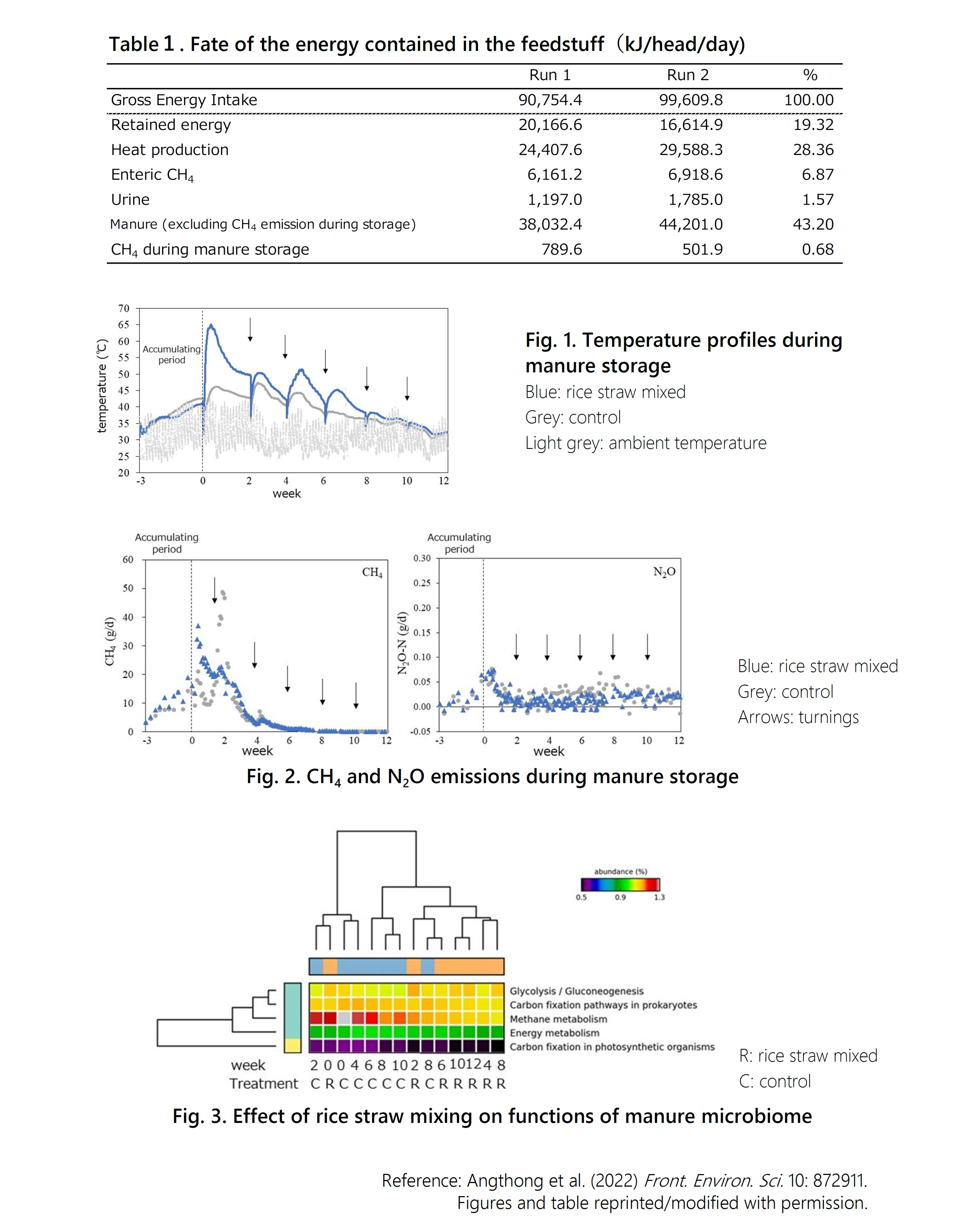A comprehensive assessment of greenhouse gas emissions from Thai beef cattle production
Description
Livestock is known to be a major source of greenhouse gases (GHGs). However, a GHG emission dataset from livestock production in Southeast Asian countries is still lacking. There is a strong need for a CH4 conversion factor(Ym value)dataset or emission factor (EF) value for each manure management category. Moreover, some developed countries have independent datasets, while no dataset covers both. Here, we provide the dataset that covers both enteric CH4 and GHG emissions during manure storage from a Thai native beef cattle production system. In addition, we assess the effect of mixing rice straw (RS), which is an abundant and ready-to-use resource.
Four Thai native cattle were fed a restricted amount (2% of BW) of a diet comprised of 70% Pangola grass and 30% commercial concentrate to meet their digestible energy requirements. The emission of enteric CH4 was measured by the head-hood system for 6 days in three periods, and the manure was accumulated in the dynamic chamber system coupled with GC-FID and ECD. Five hundred kg of manure with and without 25 kg of rice straw mixture were put in the chamber for 12 weeks and mixed every 2 weeks. Dry matter (DM) intake for runs 1 and 2 was 5.4 and 5.6 kg/d, while DM digestibility was 53.68 and 55.42%, respectively. Digestibility of organic matter, crude protein, and ether extract was also in the range of typical values for the region. The Ym value was 6.87%GEI (gross energy intake) and CH4 emission from manure storage was 0.68%GEI (Table 1). Mixing of RS significantly affected manure temperature, reaching 65.1℃–66.2℃ in the RS mixed pile while that of the control pile ranged between 43.8℃ and 47.4℃ (Fig. 1). There was a high variation in the gas emission; the CH4 emission from the RS mixed pile showed a lower tendency while there was no significant effect on the total CH4 emission (Fig. 2A). The same trend was observed for N2O emission (Fig. 2B). An analysis of the relationship between the estimated function of manure microbiome and GHG emission shows that a significant treatment effect was obtained on methane metabolism at the beginning (Fig. 3), and it agrees well with the mitigation of the peak CH4 emission in the RS mixed manure (Fig. 4).
This information can be utilized as the EF value for Thailand’s national GHG inventory. The use of rice straw as a bulking agent can enhance OM degradation in the manure and suppress the activity of methanogens, but it should be noted that its effect may be limited for small-scale farmers with small amounts of manure.
Figure, table
- Research project
- Program name
- Term of research
-
FY2017–2021
- Responsible researcher
-
Maeda Koki ( Crop, Livestock and Environment Division )
Cai Yimin ( Crop, Livestock and Environment Division )
Angthong Wanna ( Department of Livestock Development, Ruminants Feeding Standard Research and Development Center, Thailand )
Kaeokliang Ornvimol ( Department of Livestock Development, Ruminants Feeding Standard Research and Development Center, Thailand )
Kamphayae Sukanya ( Department of Livestock Development, Ruminants Feeding Standard Research and Development Center, Thailand )
Mori Akinori ( Institute of Livestock and Grassland Science, NARO )
Suzuki Tomoyuki ( Institute of Livestock and Grassland Science, NARO )
ORCID ID0000-0002-5313-7647KAKEN Researcher No.: 70391175Kitwetcharoen Haruthairat ( Khon Kaen University )
- ほか
- Publication, etc.
-
Angthong et al. (2022) Front. Environ. Sci. 10:872911.https://doi.org/10.3389/fenvs.2022.872911
- Japanese PDF
-
2022_A02_ja.pdf1.2 MB
- English PDF
-
2022_A02_en.pdf853.45 KB
* Affiliation at the time of implementation of the study.

